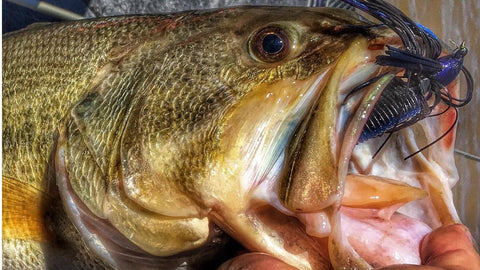By: Shaye Baker
A jig and a Texas rig aren’t necessarily interchangeable, but they can often be used to target the same fish. I consider a Texas rig to be more of a horizontal presentation, while a jig is used more vertically. Though in reality, the two assumptions aren’t absolutes when you start breaking down the different types of jigs and all the baits you could use on a Texas rig.
So today, we’re going to look at some of the intricate differences between a Texas rig and a jig and shed some light on when you should use each. Let’s get started.

The Basics
A basic Texas rig has three parts: a weight, a hook and a soft plastic lure. You run the weight up your line, tie the hook on and then select a worm, lizard, tube, craw, creature or other style soft plastic to rig up on it.A basic jig has a few parts, depending on how you look at it. There’s a hook with lead, Tungsten or some other material molded onto it to add weight. Then there’s a rubber or silicone skirt and lastly a jig will typically be trailed by some sort of soft plastic. But there are dozens of different styles of jigs to choose from. You have football, Arkie, skipping, pitching, casting and swimming jigs as well as several more.
When deciding whether to use a jig or a Texas rig, it’s important to realize that both could work given the same set of conditions. It’s often more dependent on how the baits are being fished—vertically or horizontally (and then making sure you have the right jig or Texas rigged soft plastic for the job).

Fishing Horizontally
“Fishing horizontally” refers to casting and dragging a bait back. With this style of fishing, the first option I’d go with is a Texas rigged worm, and here’s why.
When fishing horizontally, a fish tends to stalk the bait and get a really good look at it. So, a longer bait with a softer, slower action like a ribbon tail worm or a lizard does a really good job of enticing a trailing bass into striking. However, there are times (especially in the colder winter and pre-spawn months) when a football jig is the way to go when fishing horizontally like this.
Whereas a slow-moving worm works better in the summer when fish are worn out and less aggressive, a football jig rigged with a craw style trailer is the perfect option for a pre-spawn bass looking to knock down a big meal. This is not to say a Texas rigged worm won’t work in the winter and a football jig won’t work in the summer. But these two baits do a better job of matching the hatch and triggering strikes in their respective seasons.
These are simply starting points, though.

Fishing Vertically
Fishing vertically can mean anything from flipping stumps and bushes in a foot of water to dock posts in 20 feet of water, or standing timber, poles or any other vertical cover you might find. For vertical fishing, I typically start with a flipping jig. The reason being, this compact bait typically falls a little straighter so it stays close to the cover better than a Texas rigged bait which is more apt to glide away from the cover.
Fishing vertically incites more of a reaction bite where fishing horizontally gives a fish more time to look at your lure and decide if it wants to eat it. So, whereas a long ribbon tail works well for a trailing bass, it won’t do the job when fishing vertically—too much plastic which gives the fish a good chance of hitting your bait but missing the hook.
Instead, using a flipping jig with a craw style trailer gives you a nice compact bait with an aggressive action will quickly catch the attention of a bass alongside cover and create an instinctive reaction strike.
There are exceptions, as there are several soft plastics that are designed specifically to be fished Texas rigged with a vertical presentation. They may not fall as straight as a flipping jig, but they’re certainly better suited for fishing vertically than a long ribbon tailed worm. And there are times where the gliding and drifting action of these style lures is exactly what you need to trigger a bite versus a fast-falling jig.

In Conclusion
As a general rule, when deciding whether to throw a Texas rig or a jig, it’s a good idea to start out fishing a Texas rigged worm horizontally and a flipping jig vertically. But these are simply starting points and don’t rule out the chance of a bite on either lure in the opposing setting.Look for a longer Texas rigged bait or football jig when trying to find something to drag across a fairly clean bottom. If you’re fishing shallow cover vertically, a flipping jig or more compact Texas rigged soft plastic woks well. And remember during certain times of the year bass are more apt to eat one over the other. If the bass are aggressive, a jig is hard to beat. If they’re more docile and lethargic, lean towards the Texas rig.
← Older Post Newer Post →


